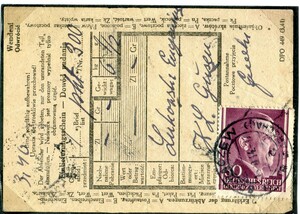CONCENTRATION CAMPS

From the estate of a local collector, we have been able to offer a superb range of camp mail covers, extending from before the war, through to the last days.
Camp mail is a dark subject, and it is obviously a case of respect and remembrance for those who died. In many cases we are able to record the names of inmate writers in the list descriptions.
Through mail of this era, we can understand the history of how camps came from small beginnings to reaching a final toll of millions of people from most nations of Europe.
From 1933 many Germans were arrested without fair trial and imprisoned in makeshift factories, camps or barracks. Mainly these were Communists, but included Social Democrats, priests and intellectuals. (Similar arrests in Stalin's Russia also dragged in philatelists, on account of their internationalist tendencies). In Germany, the guards were usually SA members, but after their purge, were replaced by SS in 1934.
It was cheaper and more productive to build on a large scale. Dachau, a former munitions factory, was used as a model, taking in German Jews, Gypsies, religious extremists, and anti-socials, also Austrians in 1938 . A couple of pre-war Dachau covers are usually in our stock.
With the conquest of Poland, Czechoslovakia, and further east, numbers increased dramatically. The camps were designed to be economically efficient, exploiting forced labour of the stronger, and fast extermination through cold, starvation, disease, gassing or shooting of the weak.
Ravensbruck was the first camp to be designated officially as a women's camp (sometimes offered).
Sachsenhausen had a special unit producing forged British banknotes and also propaganda "forgeries" of British stamps (for some examples of the stamps, see our listing).
Mauthausen (near Linz in Austria) was notorious for its quarries where inmates were worked to death (sometimes available).
With the invasion of Russia, thousands of captured Russians were brought into Germany, some to the camps, others used as slave labour on the land or in factories. Special stationery was used by the labourers; there are a couple of these Ostarbeiter cards on this list.
Most camps were in Greater Germany, but some of the worst camps were further east in Poland, or occupied former-Soviet lands. Belzec, Chelmno, Sobibor and Treblinka were extermination camps intended to be discreet and hidden, as arrivals were killed immediately and no inmate mail was permitted at all.
In the KZ (concentration) camps,neither Jews nor Russian PoWs were allowed to send or to receive mail. In the associated work camps or factories, mail was sometimes possible.
In Western Europe, a camp was set up in Natzweiler, formerly France, but became within German-seized Alsace-Lorraine.
The only other KZ camp in Western Europe was at Herzogenbusch, Netherlands (rarer, but can sometimes be found). This was mainly a transit point for Dutch Jews, student and resistance fighters before they were sent further east.
Most camps had numerous sub-camps, associated work groups and factories where the fitter prisoners worked for a shorter or longer time, or as transit camps for new people arrested. The sub-camp names and locations were well recorded during the early postwar investigations and trials.
Many foreigners were also persuaded by promises or a pistol to go to Germany to work. Mostly they were paid, but the work was hard, and leaving was usually difficult. The arrangements were variable and complex and less is known of their role or numbers employed. Some examples from French workers are can be found in our stock. There is scope for more research. The use of "Lager" in the front address (or that of sender on the reverse) is helpful, though the term "Lager" was also used for camps housing German children or evacuees.
For some further reading and research, see
"German Concentration Camps 1933-1945", 3 volumes by Erik Lordahl, Norway, 2000. (Background and postal system)
"Das nationalsozialistische Lagersystem" Martin Weinmann, Frankfurt, 1990. (Categories of camps and sub-camps and factories, extensive listings and statistics, 1168 pages)
- Published
- 15/08/23 06:40:00 AM
